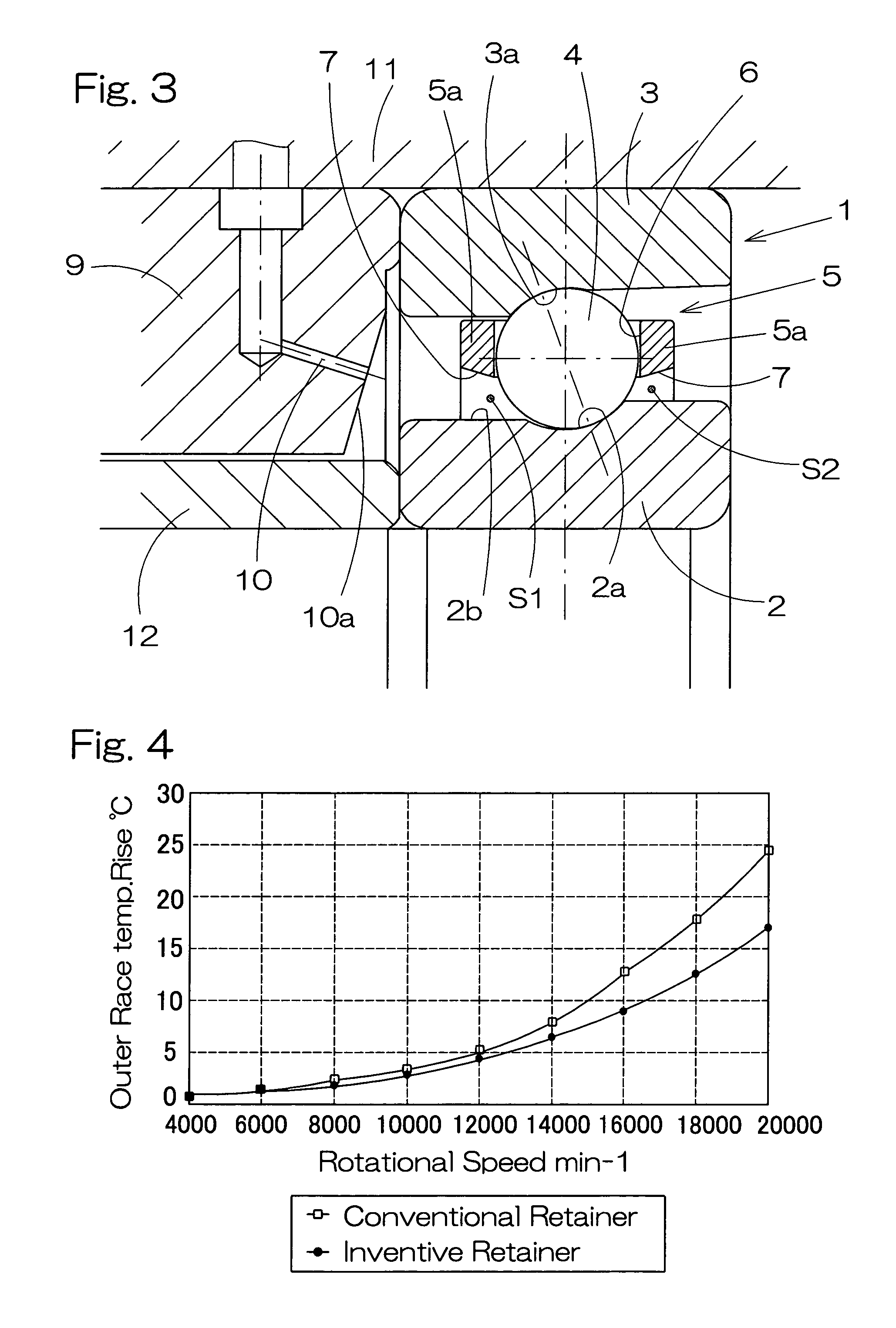Rolling element retainer and rolling bearing assembly using the same
- Summary
- Abstract
- Description
- Claims
- Application Information
AI Technical Summary
Benefits of technology
Problems solved by technology
Method used
Image
Examples
first embodiment
[0089]FIG. 4 is a chart showing results of tests conducted to determine to what extent the temperature of the outer race increases in the rolling bearing assembly 1 of the foregoing embodiment of the present invention and, also, in the conventional rolling bearing assembly 51 shown in and described with reference to FIGS. 19 and 20, while the air / oil lubrication was performed during the operation of the rolling bearing assembly. The conventional rolling bearing assembly 51 is of a type, in which the rolling element retainer 55 has the inclined annular faces 57 formed merely by chamfering the opposite end portions of the inner peripheral surface of the retainer 55 and is, except for this feature, similar in structure to the rolling bearing assembly 1 shown and described in connection with the present invention.
[0090] The specification of the retainers 5 and 55 and the test conditions are shown in Tables 1 and 2, respectively.
TABLE 1Retainer SpecificationsRetainerRetainer5 (FIG. 1)5...
third embodiment
[0104] According to the present invention, the lubricant oil supplied from the nozzle member 9 is jetted onto that portion of the outer peripheral surface of the inner race 2 of the angular ball bearing assembly 21 to efficiently lubricate the inside of the bearing assembly 21. Since, as hereinabove described, the presence of the annular tapered surface area 3b adjacent the bearing rear side g facilitates the drainage of the lubricant oil from the gap a delimited between the outer race 3 and the retainer 5, the heat generation resulting from the stirring of the lubricant oil can advantageously be suppressed to thereby increase the lubricity.
[0105] Referring now to FIG. 10, there is shown a spindle device 40 utilizing the angular ball bearing assembly 21 of FIG. 7. The spindle device 40 is generally utilized in machine tools and includes a spindle 15 having one end 15a to which a chuck of a tool or a work is mounted. This spindle 15 is rotatably supported by a plurality of, for examp...
second embodiment
[0109] A fourth preferred embodiment of the present invention will now be described with particular reference to FIGS. 11 an 12. The rolling bearing assembly shown therein is an angular ball bearing assembly 21A similar in structure to the angular ball bearing assembly 21 (FIG. 7) of the present invention.
[0110] However, the angular ball bearing assembly 21A differs from the angular ball bearing assembly 21 in that, in place of the annular tapered surface area 3b formed in the shoulder portion A of the inner peripheral surface of the outer race 3 shown in FIG. 7, a portion B1 of the outer peripheral surface of the retainer 5 on one side of each pocket-formed portion (or a circumferential portion in which the pockets are formed and having a width corresponding to a pocket diameter) adjacent the rear side g of the outer race 3 and a portion B2 of the outer peripheral surface of the retainer 5 on the opposite side of the respective pocket-formed portion adjacent the bearing front side ...
PUM
 Login to View More
Login to View More Abstract
Description
Claims
Application Information
 Login to View More
Login to View More - R&D
- Intellectual Property
- Life Sciences
- Materials
- Tech Scout
- Unparalleled Data Quality
- Higher Quality Content
- 60% Fewer Hallucinations
Browse by: Latest US Patents, China's latest patents, Technical Efficacy Thesaurus, Application Domain, Technology Topic, Popular Technical Reports.
© 2025 PatSnap. All rights reserved.Legal|Privacy policy|Modern Slavery Act Transparency Statement|Sitemap|About US| Contact US: help@patsnap.com



